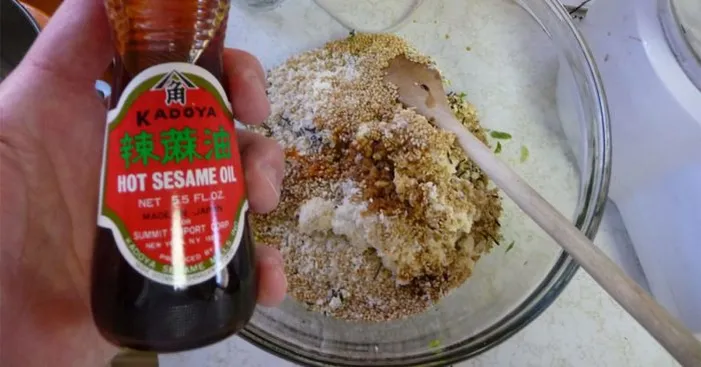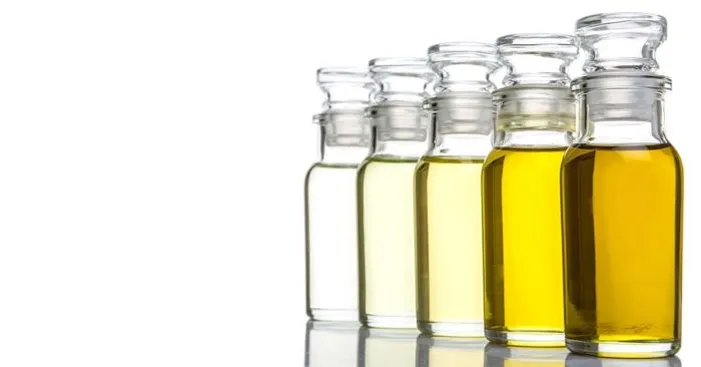Table of Contents

The benefits of sesame oil are not only diverse but also safe to try regardless of your condition.
This oil comes from the seeds of a plant called Sesamum Indicum or simply sesame plant.
There are 3 types of sesame oil: unrefined, refined, and fried or roasted.
Each version of these sesame oils has its uses and own virtues which we are going to talk about later on in detail.
Sesame oil was long used to prevent many diseases, to lose weight, and for cosmetic purposes for daily skincare.
In Japan, sesame oil is used in many dishes including the Japanese fried dish Tempura.
Apart from the distinguished taste of sesame oil, it is very resistant to oxidation compared to vegetable oil and that makes it a healthier choice.
In this article, We gathered all the information you need to learn about the benefits of sesame oil, how it is used alongside the precautions you need to know before using it and a few tips on how to buy and store sesame oil.
History of sesame oil:

The first sesame plants were originally cultivated in East Africa and Indonesia about 4000 years ago.
Sesame oil and seeds were always considered to be linked to gods for example:
In ancient Greece: Hera applied a sesame lotion on her body before seducing Jupiter.
In ancient Egypt: sesame seeds were present in the temples of Pharaohs.
During his journeys, Marco Polo did mention that Persians did not know olive oil and they use sesame oil instead.
Nowadays, India is the world’s top producer of sesame and the top consumers of sesame oil are Tanzania, China, and Myanmar.
Benefits of sesame oil:

Sesame oil nutritional composition:
Sesame oil generally contains about 38% oleic acid, 40% linoleic acid, 5% palmitic acid, and 0.5% of arachidonic acid.
Also, it contains omega 3, omega 6, omega 9, vitamin B2, vitamin E, phytosterols, and phospholipids.
However, the most abundant micro-nutrient in sesame oil is vitamin e with more than 100% of the daily need per ½ cup.
The digestibility and absorption of sesame oil is oil which means almost none of it goes to waste.
Dietary health benefits of sesame oil:

Anti-inflammatory:
Inflammation is a body response we all deal with whether we get burnt, cut, or even deal with internal inflammation due to muscle irritation.
You can say it is the counterpart of “body healing”, the more inflamed an area is, the more sick the person should be …
To help calm down external and internal inflammation our bodies need at least 4g of dissolved fat per day (mainly linoleic and oleic acids)
Therefore, consuming sesame oil or rubbing it against an inflamed area would certainly encourage the healing process.
Good for the heart:
People generally have a misconception that any type of oil is full of bad cholesterol and fats and not good for the heart.
This is a false claim as many natural oils promote the well-being of the heart.
For instance, sesame oil boosts blood circulation by lowering cholesterol and preventing fats from sticking to the arteries’ walls.
This is because sesame oil is abundant in sesamolin and sesamin, two natural elements that nurture the heart.
Other dietary benefits of sesame oil:
- Reduces blood clotting.
- Regulates blood pressure.
- Relieves stomach cramps during menstruation.
- Improves immunity.
- Strengthens teeth and gum enamel.
- Reduces the side effects of asthma and bronchitis.
- Lowers blood sugar levels.
- Strengthens cardiovascular health.
Cosmetic health benefits of sesame oil:

The benefits of sesame oil made it one of the ingredients of many skin lotions.
This is because this oil has anti-fungal and anti-inflammatory properties that promote healthy skin.
Nourishes the skin:
Sesame oil can be a natural substitute for all of the skin lotions that claim to be 100% natural.
By applying then rubbing it on the skin, it will:
- Promotes recovery for damaged skin by reducing inflammation and providing nutrients.
- Moisturize dry skin and help protect it from dehydration.
- Maintains tan and skin tone.
- Reduces stretch marks and removes old acne spots.
- Offers medium protection from UV radiation.
Good for the hair:
The benefits of sesame oil also include benefits for the hair especially if it is used as part of a natural hair mask.
Sesame oil benefits the hair in many ways including:
- Preserves the natural color and limits the effects of grey hair.
- Stimulates hair growth by providing essential fatty acids.
- Reduces inflammation and dandruff by protecting the scalp from dehydration.
- Softens the hair by covering hair fossils which also gives the hair a natural shine.
- Prevents hair loss by nourishing the roots of the hair.
Other cosmetic benefits of sesame oil:
- Cleaning the skin from dead cells and bacteria.
- Maintains a balanced ratio of lipid-water in the skin.
- Promotes collagen production which protects the skin from sagging.
- Restores the protection epidermis of the skin.
- Remove pimples.
- Delays skin aging.
- Softens and protects the toddler’s skin.
- Promotes longer and deeper sleep.
- Prevents hair breakage.
How to get the benefits of sesame oil?
Sesame oil kitchen uses:

The best thing about this oil is that it offers a wide diversity of usage as you can use it baked, uncooked, for frying and roasting …
Unrefined sesame oil can only support medium heat (below 350°F, 180°C) and would burn if it exceeds that temperature.
Nonetheless, refined sesame oil has better resistance to burning and can reach up to 450°F before it burns.
On the other hand, sesame oil extracted from roasted seeds have the lowest burning temperature and you shouldn’t cook with it.
However, roasted sesame oil has an enhanced nutty flavor which can be ideal for an uncooked recipe.
Uses of refined sesame oil:
This type is very light and almost has no flavor which makes it perfect for baking recipes.
Among the many uses of refined sesame oil:
- In sauces: Since they have little to no flavor, it will reduce the flavor intensity you may have if you cook using corn or olive oil.
- Bread: For pastry and baking recipes, if you need an oil that doesn’t add a nutty flavor to your dish, you can use refined sesame oil.
- Roasting: to roast your potatoes, meat, or vegetables you can grease them with refined sesame oil instead of other vegetable oil.
- Marinade: if you are cooking chicken, beef, or any type of meat, soak it in a mixture of honey and refined sesame oil for 4 to 6 hours before cooking it.
Unrefined sesame oil:
This type of oil doesn’t have medium resistance to heat unlike refined oils, however, it has a mild nutty flavor.
Mostly, unrefined sesame oil is used in recipes that don’t require cooking such as:
- Dips: homemade dips like tahini or chickpeas with olive oil … you can use unrefined sesame instead.
- Salad dressing: As a replacement for olive oil, you can use sesame oil as a dressing for salads and this will give it an Asian touch.
- Rice and pasta: you can use a little unrefined sesame oil to avoid pasta and rice from sticking.
- A remedy for constipation: unrefined
Sesame oil medicinal uses:

The pure version of sesame oil offers many benefits which can treat several conditions.
For instance, it can be used as a moisturizing oil to treat dry skin and relieve muscle tension.
Sesame oil has a lot of benefits for the digestive system and drinking 1tsp in the morning can relieve constipation.
As a natural lip balm, applying sesame oil on the dried lips helps repair and moisturize them.
A few drops of sesame oil in the mouth is a good natural treatment for bad breath and bleeding gums.
Extracting sesame oil at home:

Generally speaking, sesame oil is extracted through specialized machines within factories.
However, there are simple tools anyone can use to extract sesame oil at home:
Extracting sesame oil using another oil:
Ingredients:
- 1 cup of olive or corn oil.
- 1 cup of sesame seeds.
- A piece of cloth.
Steps:
- Start by grinding sesame seeds until you obtain a powder.
- Now place the powder in a pan and add the vegetable oil then heat the mixture until it starts boiling.
- Remove the pan and let it cool down then start filtering the mixture using the piece of cloth.
- The obtained oil can then be put in a bottle and stored at room temperature.
Extracting sesame oil using water:
Ingredients:
- 1lbs of sesame seeds (0.5 Kg).
- ½ cup of water.
- A piece of cloth.
Steps:
- Grind the sesame seeds into flour.
- Now add a tablespoon of water and mix, repeat the process by adding a tbsp. of water and mix until you obtain a paste.
- Apply pressure on the paste using your hands to get the most of the oil out.
- Then using the piece of cloth, filter the obtained oil to remove impurities.
- Collect the filtered oil in a glass jar or bottle then store it at room temperature for future uses.
Precautions before you use sesame oil:

Generally, sesame oil is safe to consume and use on the skin or hair.
Nonetheless, there are few exceptional cases where sesame oil may cause few side effects.
For instance, some people may be allergic to sesame and could experience:
- Hives.
- Itching.
- Swelling of the lips and tongue.
- Hardship swallowing.
- Anaphylaxis reaction.
Because of that, if you are new to sesame oil it is better to start slowly with its consumption or external use on the skin.
Specifically, the daily safe dietary dose of sesame oil is about 1 to 2 tbsp per day.
Storing sesame oil:

The best way to store any type of vegetable oil is by storing it in a glass bottle away from light.
In fact, plastic and oils dissolve into each other, which could affect the purity of the oil.
The speed of this reaction is very long which means it’s okay to use a plastic bottle to store sesame oil for a short time (less than 2 weeks).
However, for optimal preservation, it is always better to use glass bottles to store sesame oil.
In addition, this type of oil should stay away from light to avoid oxidation and deterioration and preserve its flavor and pureness.
Buying sesame oil:

There are a few easy tips anyone can use to choose the best sesame oil on the market.
Pure sesame oil is clear, transparent, has a light red color, and has no solids or impurities.
Some sesame oil products are mixed with rapeseed or cottonseed oils or any other vegetable oil.
Usually, mixed sesame oils tend to have a darker color than pure sesame oil.
You can use this trick to tell the difference between pure and mixed sesame oils:
- On a calm water surface, a droplet of pure sesame oil will have no color and shall create large oil flowers.
- Unlike pure sesame oil, the mixed version’s droplet will have a color and shall create smaller oil flowers.
